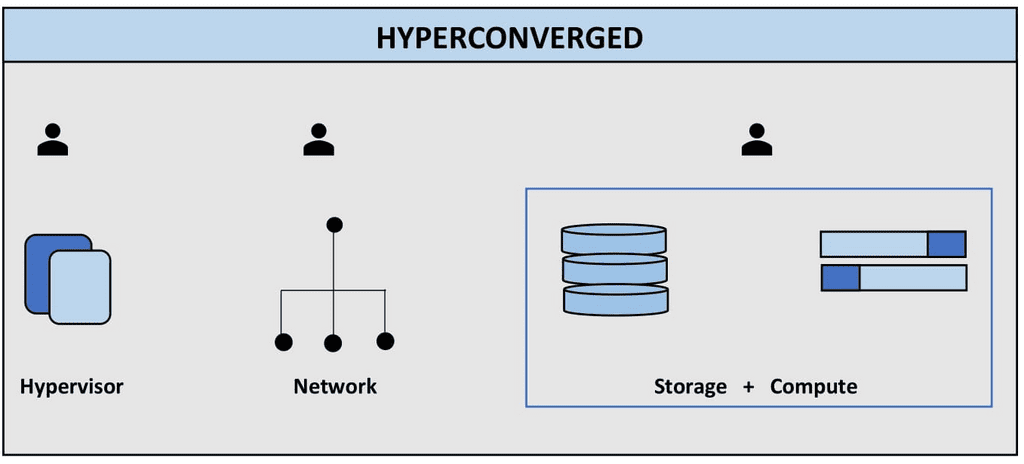In today’s rapidly evolving IT landscape, two notable architectural approaches — converged infrastructure (CI) and hyper-converged infrastructure (HCI) — have gained prominence in IT environments and data centers.
Converged infrastructure combines the computing, storage, networking, and virtualization resources into a pre-packaged and integrated system that a single vendor usually provides. At the same time, HCI takes convergence further and leverages a software-defined technology to integrate these resources on a single hardware platform.
A clear understanding of these architectural approaches will empower IT professionals to align their infrastructure choices according to their organization’s needs, goals, and resource constraints. Only when IT professionals understand the strengths, weaknesses, and trade-offs associated with converged infrastructure (CI) and hyper-converged infrastructure (HCI) can they optimize their infrastructure, enhance operational efficiency, and ensure a better return on investment.
This article will comprehensively explain the variance between converged and hyper converged infrastructure. So, IT professionals will have the necessary knowledge to evaluate and choose the most suitable infrastructure for their organizations. The subsequent sections will delve deeper into CI and HCI systems’ characteristics, benefits, challenges, and real-world use cases. You will also find a detailed comparison of the critical attributes of CI and HCI, so it will be easier to choose between the two approaches.
Table of Contents
Short on time? Here’s a comparison table between Converged Infrastructure (CI) and Hyperconverged Infrastructure (HCI):
| Feature | Converged Infrastructure (CI) | Hyperconverged Infrastructure (HCI) |
| Architecture | Hardware components are tightly integrated and pre-optimized | Software-defined infrastructure with virtualization |
| Scalability | Scaling done in larger increments | Granular scaling allows for more flexibility and agility |
| Management | Requires separate management tools for each component | Centralized management simplifies administration |
| Complexity | More complex due to multiple components and management interfaces | Simplified architecture reduces complexity |
| Performance | Higher performance due to specialized hardware | Performance depends on the underlying hardware capabilities |
| Cost | Higher upfront costs due to specialized hardware | Lower upfront costs as it utilizes commodity hardware |
| Flexibility | Less flexible as scaling requires additional hardware | More flexible, allows for scaling resources independently |
| Vendor Lock-in | Potential vendor lock-in due to integrated components | Less vendor lock-in as it uses standardized hardware |
| Use Case Suitability | Well-suited for large enterprises with specific needs | Suitable for small to mid-sized organizations or remote sites |
Converged Infrastructure
Converged infrastructure refers to a pre-integrated and unified system that combines computing, storage, networking, and virtualization into a single architecture. Its key characteristic is consolidating multiple infrastructures components into single, standardized, and validated configurations. By providing a “plug-and-play” approach, it is designed to streamline data center operations and optimize the system for specific workloads easily.
Components and architecture:
Converged infrastructure is a pre-packaged system that combines computing, storage, networking, and management software. It simplifies deployment and management and can be scaled easily to meet changing needs.
- Compute nodes host virtual machines and run applications.
- Storage arrays provide shared storage for data.
- Network switches facilitate communication between compute nodes and storage arrays.
- Management software provides centralized management and monitoring.
Advantages and benefits of Converged Infrastructure:
Converged infrastructure simplifies deployment, management, and scalability while improving performance and lowering operational costs.
-
Simplified deployment:
Pre-integrated and pre-configured components eliminate the need for complex integration tasks.
-
Reduced management complexity:
A unified management interface makes monitoring and managing the entire infrastructure from a single point easy.
-
Enhanced scalability:
Organizations can add or remove resources as needed, ensuring flexibility and adaptability.
-
Improved performance:
Converged infrastructure optimizes performance by aligning hardware components and leveraging advanced technologies.
-
Lower operational costs:
The standardized and validated architecture of converged infrastructure reduces operational costs associated with integration, troubleshooting, and maintenance.
Challenges and limitations of converged infrastructure:
-
Vendor lock-in:
One of the significant challenges with converged infrastructure is it relies on a single for the entire solution. This will lead to potential vendor lock-in and limited flexibility in choosing the components.
Additionally, Converged infrastructure can be costly, inflexible, and limited in scalability.
Hyper-converged Infrastructure
Hyper-converged infrastructure (HCI) is a software-defined system that tightly integrates computing, storage, and networking resources into a single system. HCI systems typically comprise commodity x86 servers, software-defined storage, and virtualization software. The software layer manages all of the components and provides a unified view of the infrastructure.
Components and architecture of hyper-converged infrastructure:
- x86 servers: Standard hardware units that host VMs and run HCI software.
- Software-defined storage (SDS): Pooled storage capacity managed through software-defined techniques.
- Virtualization software: Hypervisor layer for VM creation and management.
- Management tools: Centralized control and monitoring of the entire infrastructure.
Advantages and benefits of hyper-converged infrastructure:
- Scalable: HCI can be scaled up or down to meet changing needs.
- Agile: HCI can be deployed quickly and easily.
- Efficient: HCI uses resources efficiently.
- Manageable: HCI is easy to manage.
- Cost-effective: HCI is often more cost effective than traditional infrastructure.
Challenges and limitations of hyper-converged infrastructure:
- Performance: HCI may not be suitable for all use cases, such as high-performance computing.
- Complexity: Managing a large-scale HCI deployment can be complex.
- Vendor lock-in: HCI solutions may lock in organizations to specific vendors and hardware.
- Data protection: HCI requires careful planning for data protection and resilience.
Comparing Converged and Hyperconverged Infrastructures
Here’s a comparison chart between Converged Infrastructure (CI) and Hyperconverged Infrastructure (HCI) based on various factors:
| Factor | Converged Infrastructure (CI) | Hyperconverged Infrastructure (HCI) |
| Scalability and Flexibility | Scalability achieved through adding larger increments of resources (compute, storage) | Granular scalability allows independent scaling of resources |
| Cost-effectiveness | Higher upfront costs due to specialized hardware | Lower upfront costs by utilizing commodity hardware |
| Management and Simplicity | Separate management tools for each component | Centralized management simplifies administration |
| Performance and Efficiency | Specialized hardware can provide higher performance | Performance depends on the underlying hardware capabilities |
| Vendor Lock-in and Ecosystem | Potential vendor lock-in due to integrated components | Less vendor lock-in as it uses standardized hardware |
| Use Case Suitability | Well-suited for large enterprises with specific needs | Suitable for small to mid-sized organizations or remote sites |
Featured NBD2018groupRayleigh, CC BY-SA 4.0, via Wikimedia Commons




